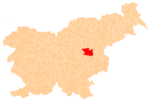Huda Jama
| Huda Jama | |
|---|---|
 | |
_location_map.svg.png) Huda Jama | |
| Coordinates: 46°9′31.46″N 15°11′10.28″E / 46.1587389°N 15.1861889°ECoordinates: 46°9′31.46″N 15°11′10.28″E / 46.1587389°N 15.1861889°E | |
| Country |
|
| Traditional region | Styria |
| Statistical region | Savinja |
| Municipality | Laško |
| Area | |
| • Total | 0.81 km2 (0.31 sq mi) |
| Elevation | 335.8 m (1,101.7 ft) |
| Population (2002) | |
| • Total | 71 |
| [1] | |
Huda Jama is a settlement east of Laško in east-central Slovenia. The area was traditionally part of the Styria region. It is now included with the rest of the Municipality of Laško in the Savinja statistical region.[2]
History
Lignite mining was begun at Huda Jama in 1813 by the Gadolla family. The mine was operated by various owners until 1855, when Paul von Putzer transferred operations to Brezno in 1855. Mining was resumed in Huda Jama in 1890.[3]:183 During the Second World War, the Partisans attacked German positions at Huda Jama on 2 July 1942 and 25 March 1944. After the second attack, they used the mine in the settlement as a shelter.[3]:195
Mass grave
The Commission on Concealed Mass Graves in Slovenia has identified the site of a mass grave with remains of bodies of hundreds of victims of political killings from the period immediately after the Second World War in a nearby abandoned coal mine known as the Barbara Pit (Slovene: Barbara rov), also known as the Huda Jama Mass Grave (Grobišče Huda jama) or the Saint Barbara Abandoned Mine Shaft Mass Grave (Grobišče v opuščenem rudniškem jašku Sv. Barbara).[4][5]
Notable people
Notable people that were born or lived in Huda Jama include:
- Franc Suher (1861–1944), schoolmaster and drawing methodologist[3]:183
References
- ↑ Statistical Office of the Republic of Slovenia
- ↑ Laško municipal site
- ↑ 3.0 3.1 3.2 Savnik, Roman, ed. 1976. Krajevni leksikon Slovenije, vol. 3. Ljubljana: Državna založba Slovenije.
- ↑ Finding of mass graves
- ↑ Barbara Pit Mass Grave on Geopedia (Slovene)
